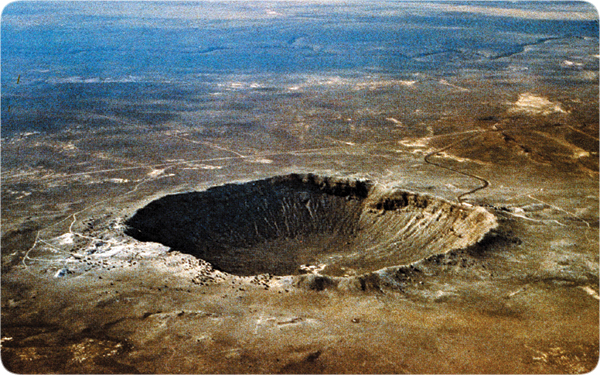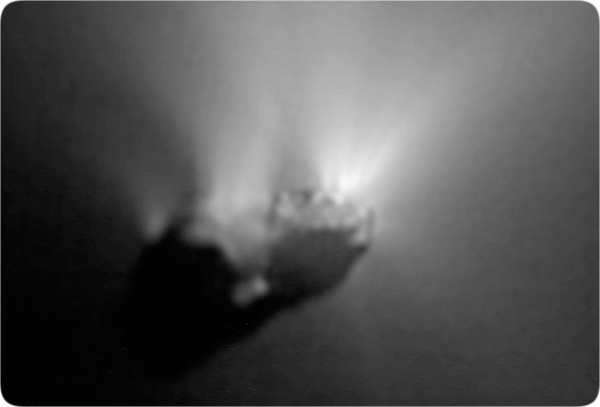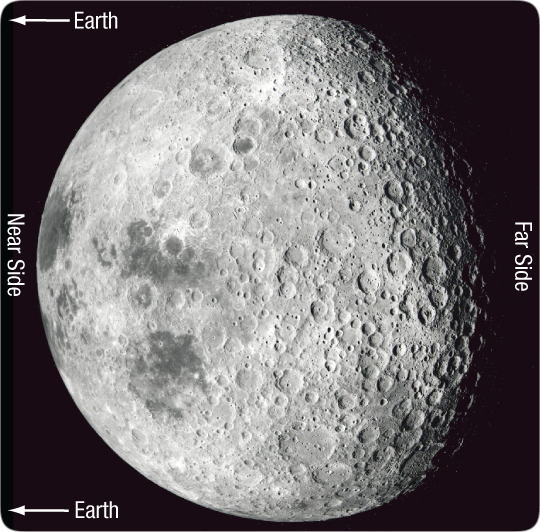Below is the online edition of In the Beginning: Compelling Evidence for Creation and the Flood,
by Dr. Walt Brown. Copyright © Center for Scientific Creation. All rights reserved.
Click here to order the hardbound 8th edition (2008) and other materials.
The Origin of Comets
SUMMARY: Past explanations for how comets began have serious problems. After a review of some facts concerning comets, a new explanation for comets will be proposed and tested. During the first weeks of the flood, the fountains of the great deep launched water, rocks, and muddy droplets that later gravitationally merged around the larger rocks. The fountains expelled an “ocean” of high-pressure, supercritical water that jetted up through the atmosphere and into the vacuum of space. Today, these merged bodies match comets in size, number, density, composition, spin, texture, strength, chemistry (organic and inorganic), and orbital characteristics. After a comparison of theories with evidence, problems with the earlier explanations will become obvious.

Figure 166: Arizona’s Meteor Crater. Comets are not meteors. Comets are like giant, dirty, exceedingly fluffy “snowballs.” Meteors are rock fragments, usually dust particles, falling through earth’s atmosphere. “Falling stars” streaking through the sky at night are usually dust particles thrown off by comets years ago. In fact, every day we walk on comet dust. House-size meteors have formed huge craters on Earth, the Moon, and elsewhere. Meteors that strike the ground are renamed “meteorites,” so the above crater, 3/4 mile wide, should be called a “meteorite” crater.
On the morning of 14 December 1807, a huge fireball flashed across the southwestern Connecticut sky. Two Yale professors quickly recovered 330 pounds of meteorites, one weighing 200 pounds. When President Thomas Jefferson heard their report, he allegedly said, “It is easier to believe that two Yankee professors would lie than that stones would fall from heaven.” Jefferson was mistaken, but his intuition was no worse than ours would have been in his time. Today, many would say, “The Moon’s craters show that it must be billions of years old” and “What goes up must come down.” Are these statements common mistakes in our time?
As you read this chapter, test such intuitive ideas and alternate explanations against evidence and physical laws. Try to grasp the explosive and sustained power of the fountains of the great deep. (Later chapters will make this even clearer.) You will also see why the Moon is peppered with craters, as if someone had fired large buckshot at it. Comets are “out of this world.”
Comets may be the most dynamic, spectacular, variable, and mysterious bodies in the solar system. They even contain complex organic molecules—including trace amounts of the amino acid glycine, a building block of life on earth.1 Early scientists discovered other types of organic matter in comets “similar to organic matter of unquestioned biological origin on Earth,” and concluded that they came from “decomposed organic bodies.”2
While simple organic compounds are not always a product of life, complex organic compounds almost certainly are. Furthermore different comets are expelling multiple organic compounds.3 Today, a popular belief is that comets brought life to Earth. Instead, comets have traces of life from Earth.4 [See “Rosetta Mission” on p. 311.]
Comets orbit the Sun. When closest to the Sun, some comets travel more than 350 miles per second! Others, at their farthest point from the Sun, spend years traveling less than 15 miles per hour. A few comets travel so fast they will escape the solar system. Even fast comets, because of their great distance from Earth, appear to “hang” in the night sky, almost as stationary as the stars. Comets reflect sunlight and fluoresce (glow). They are brightest near the Sun and sometimes visible in daylight.
A typical comet, when far from the Sun, resembles a dirty, misshapen snowball, a few miles across. About 38% of its mass5 is frozen water—but this ice is extremely fluffy, with much empty space between ice particles. The rest is dust and various chemicals. As a comet approaches the Sun, a small fraction of the snowball (or nucleus) evaporates, forming a gas and dust cloud, called a coma, around the nucleus. The cloud and nucleus together are called the head. The head’s volume can be larger than a million Earths. Comet tails are sometimes more than an astronomical unit (AU) long (93,000,000 miles), the average Earth-Sun distance. One tail was 3.4 AU long—enough to stretch around Earth 12,500 times.6 Sunlight and solar-wind propel comet tails away from the Sun, so comets traveling away from the Sun move tail-first.

Figure 167: Nucleus of Halley’s Comet. When this most famous of all comets last swung by the Sun in 1986, five spacecraft approached it. From a distance of a few hundred miles, Giotto, a European Space Agency spacecraft, took six pictures of Halley’s black, 9 x 5 x 5 mile, potato-shaped nucleus. This first composite picture of a comet’s nucleus showed 12–15 jets venting gas at up to 30 tons per second. (Venting and tail formation occur only when a comet is near the Sun.) The gas moved away from the nucleus at almost a mile per second to become part of the comet’s head and tail. Seconds after these pictures were taken, Giotto slammed into the gas, destroying the spacecraft’s cameras.
Comet tails are extremely tenuous—giant volumes of practically nothing. Stars are sometimes observed through a comet’s head or tail; comet shadows on Earth, even when expected, have never been seen. One hundred cubic miles of comet Halley’s tail contains much less matter than in a cubic inch of air we breathe—and is even less dense than the best laboratory vacuum.
In 1998, billions of tons of water-ice mixed with the soil were found in deep craters near the Moon’s poles. As one writer visualized it,
Comets raining from the sky left pockets of frozen water at the north and south poles of the moon, billions of tons more than previously believed, Los Alamos National Laboratory researchers have found.7
Later, thin traces of water were found at all lunar latitudes by three different spacecraft.8 Comets are a likely source, but this raises perplexing questions. Ice should evaporate from the Moon faster than comets currently deposit it, so why does so much ice remain?9 Also, recently deposited ice has been discovered in permanently shadowed craters on Mercury,10 the closest planet to the Sun. Ice that near the Sun is even more difficult to explain. [See Figure 168.]

Figure 168: Cold Ice on Hottest Planet. Planet Mercury has an average surface temperature of 350°F ! However, layers of water ice, up to a few hundred meters thick, are permanently shielded from sunlight in craters (shown above in black) near Mercury’s poles.10 How strange. How did that water get there—and from where?
That ice could not have been on Mercury for millions of years. Meteoritic impacts would have scattered the ice into the Sun’s fiery glow or buried the ice with debris from those impacts. Nor could water have migrated into those craters from inside or on Mercury without becoming hot water vapor (or dissociated H, O, and OH) that would quickly escape into space.
Where did the water come from? Comets and asteroids, which contain vast amounts of water, are not hitting Mercury frequently today, but they may have rapidly bombarded Mercury in the relatively recent past. Obviously, Mercury’s water came from some place with considerable water. Could it have been Earth, “the water planet”?
Fear of comets as omens of death existed in most ancient cultures.11 Indeed, comets were called “disasters,” which in Greek means “evil” (dis) “star” (aster). Why fear comets and not other more surprising celestial events, such as eclipses, supernovas, auroras, or meteor showers? When Halley’s comet appeared in 1910, some people worldwide panicked; a few even committed suicide.12 In Texas, police arrested men selling “comet-protection” pills. Rioters then freed the salesmen. Elsewhere, people quit jobs or locked themselves in their homes as the comet approached.
Comets are rapidly disappearing. Some of their mass is “burned off” each time they pass near the Sun, and they frequently collide with planets, moons, and the Sun. Comets passing near large planets often are torn apart by gravitational effects or receive gravity boosts that fling them, like slingshots, out of the solar system forever. Because we have seen so many comets die, we naturally wonder, “How were they born?”
Textbooks and the media confidently explain, in vague terms, how comets began. Although comet experts worldwide know those explanations lack details and are riddled with scientific problems, most experts view the problems, which few others appreciate, as “future research projects.”
To learn the probable origin of comets, we should:
a. Understand these problems. (This will require learning how gravity moves things in space, often in surprising ways.)
b. Learn a few technical terms related to comets, their orbits, and their composition.
c. Understand and test the seven major theories for comet origins.
Only then will we be equipped to decide which theory best explains the origin of comets.
